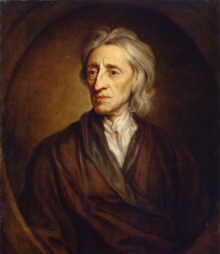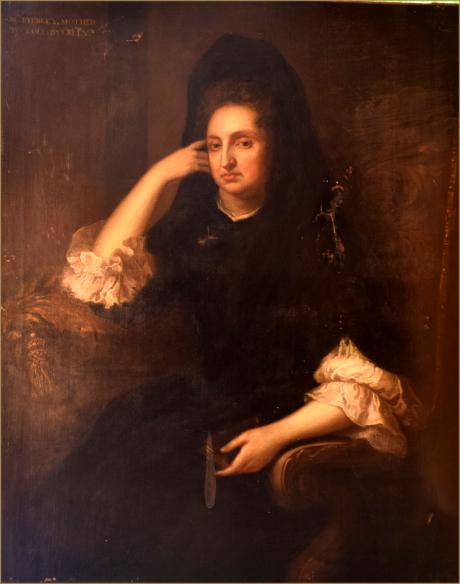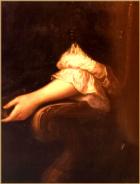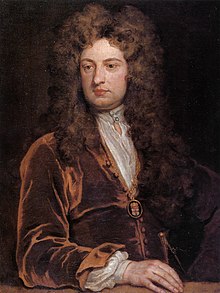"MRS BYERLEY MOTHER TO COL BYERLEY"
Christies, Lot: 64, 2nd August 1940
SIR GODFREY KNELLER
PORTRAIT OF MRS. BYERLEY, mother to Colonel Byerley,
In widows dress, seated
With inscription – 48 x 38in.
Sold for: £3.3.0 [3gns]
Buyer: Blum
Vendor: Sir Digby Legard, Bt.
Anne was the younger daughter of Sir Richard Hutton of Goldsborough Hall & Margaret Wentworth . She married Col. Anthony Byerley of Middridge Grange, (d.1667) a Royalist who commanded a regiment which was garrisoned in the house with him and his family. This body of men built up a fine reputation for their indomitable spirit, earning the label of Byerley’s Bulldogs. They served under the Marquess of Newcastle during hostilities, and are known to have fought in the Siege of York and the Battle of Marston Moor in 1644. Following the Restoration in 1660, Col. Byerley was awarded the Order of the Royal Oak for his feisty efforts. It is said that a great underground tunnel exists in the grounds of the estate, which could well date to this troubled time – indeed, King Charles I himself was supposed to have taken refuge for a time at the Grange during the war.
Anthony and Anne's Byerley’s fourth son, Robert, was born in 1660. At the age of 14 he found himself in charge of the Middridge Grange estate after the death of his father and his three older brothers. Then, in 1685, he became an MP; and a year later found himself embroiled in the Battle of Buda as part of the Holy League’s campaign against the Turks. It was during this time that he gained possession of his famous Arabian horse, which came to be known as the ‘Byerley Turk’. He took it home with him and it lived with the family at Middridge Grange, before following Robert to his new home at Goldsborough, near Knaresborough, in the mid 1690s. During its stay at Middridge, the horse served as Robert Byerley’s charger during his military forays – including the Battle of the Boyne in 1690. But what was so special about the Byerley Turk was that it was the earliest of the three founding stallions of the entire modern thoroughbred horse racing stock (the other two being the Godolphin Arabian and the Darley Arabian)… Robert married 1692 his cousin and ward Mary 1672-1727 sole heiress daughter of Elizabeth heiress of Sir Richard Hutton by Hon. Philip Wharton of Edlington. Robert married his cousin, Mary Wharton, and served as Member of Parliament representing both County Durham and Knaresborough. Before they married, In November 1690 Mary Wharton was kidnapped when travelling with her aunt, by Captain James Campbell, younger brother of Archibald Campbell, tenth earl of Argyll. Campbell forced her into marriage, apparently to acquire her inheritance. Mary was set free within 2 days, but in August 1691 she gave birth to a son named Thomas Wharton, son of James Campbell. Her marriage to Campbell was annulled by act of parliament in December 1691 and Robert and Mary married on 17 March 1692
Sir Godfrey Kneller, 1st Baronet (born Gottfried Kniller; 8 August 1646 – 19 October 1723), was the leading portrait painter in England during the late 17th and early 18th centuries, and was court painter to English and British monarchs from Charles II to George I. His major works include The Chinese Convert (1687; Royal Collection, London); a series of four portraits of Isaac Newton painted at various junctures of the latter's life; a series of ten reigning European monarchs, including King Louis XIV of France; over 40 "kit-cat portraits" of members of the Kit-Cat Club; and ten "beauties" of the court of William III, to match a similar series of ten of Charles II's mistresses painted by Kneller's predecessor as court painter, Sir Peter Lely.

Kneller was born Gottfried Kniller in the Free City of Lübeck, the son of Zacharias Kniller, a portrait painter. Kneller studied in Leiden, but became a pupil of Ferdinand Bol and Rembrandt Harmenszoon van Rijn in Amsterdam. He then travelled with his brother John Zacharias Kneller, who was an ornamental painter, to Rome and Venice in the early 1670s, painting historical subjects and portraits in the studio of Carlo Maratti, and later moved to Hamburg.

The brothers came to England in 1676, and won the patronage of the Duke of Monmouth. He was introduced to, and painted a portrait of, Charles II. In England, Kneller concentrated almost entirely on portraiture. In the spirit of enterprise, he founded a studio which churned out portraits on an almost industrial scale, relying on a brief sketch of the face with details added to a formulaic model, aided by the fashion for gentlemen to wear full wigs. His portraits set a pattern that was followed until William Hogarth and Joshua Reynolds.
Nevertheless, he established himself as a leading portrait artist in England. When Sir Peter Lely died in 1680, Kneller was appointed Principal Painter in Ordinary to the Crown by Charles II. For about 20 years (c.1682-1702) he lived at No. 16-17 The Great Piazza, Covent Garden.[6] In the 1690s, Kneller painted the Hampton Court Beauties depicting the most glamorous ladies-in-waiting of the Royal Court for which he received his knighthood from William III. He produced a series of "Kit-cat" portraits of 48 leading politicians and men of letters, members of the Kit-Cat Club. Created a baronet by King George I on 24 May 1715, he was also head of the Kneller Academy of Painting and Drawing 1711–1716 in Great Queen Street, London, which counted such artists as Thomas Gibson amongst its founding directors. His paintings were praised by Whig luminaries such as John Dryden, Joseph Addison, Richard Steele, and Alexander Pope.
On the landing in Horsham Museum hang works of art from the Museum's extensive painting collection, featuring a large 18th-century portrait of Charles Eversfield and his wife, of Denne Park House.[8] In the painting Eversfield is giving his wife some violets which signifies fidelity, love and honesty. It is likely that the picture was cut down at some time as it was unusual to stop just below the knee. It may have been painted by more than one person: someone who specialised in clothing, another in drapes, and so on, with perhaps Kneller painting the heads, for it was the portraits that gave the sitters their identity, everything else is rather formulaic.
He married a widow, Susanna Grave, on 23 January 1704 at St Bride's Church, London. She was the daughter of the Reverend John Cawley, Archdeacon of Lincoln and Rector of Henley-on-Thames, and the granddaughter of regicide William Cawley. The couple had no children.
Death
Kneller died of fever in 1723 at Great Queen Street and his remains were interred at Twickenham. He had been a churchwarden at St Mary's, Twickenham when the 14th-century nave collapsed in 1713 and was active in the plans for the church's reconstruction by John James. His widow was buried at Twickenham on 11 December 1729.
Legacy
A memorial was erected in Westminster Abbey.Kneller's will gave a pension of £100 a year to his assistant Edward Byng and entrusted Byng with seeing that all unfinished work was completed. Byng also inherited the drawings in Kneller's studio. Kneller and his wife had no children together. Most of his fortune was inherited by his grandson, Godfrey Kneller Huckle, who was the son of Agnes Huckle, Kneller's illegitimate daughter by Mrs Voss, and who took his grandfather's surname (Kneller) as a condition of his inheritance.
The site of the house Kneller built in 1709 in Whitton, near Twickenham, became occupied by the mid-19th century Kneller Hall, home of the Royal Military School of Music.
Character
"As to thinking better or worse of mankind from experience, some cunning people will not be satisfied unless they have put men to the test, as they think. There is a very good story told of Sir Godfrey Kneller, in his character of a Justice of the peace. A gentleman brought his servant before him, upon an accusation of having stolen some money from him; but it having come out that he had laid it purposely in the servant's way, in order to try his honesty, Sir Godfrey sent the master to prison."
In his hometown Lübeck there are works to be seen in the St. Annen Museum and in Saint Catherine Church. His former works at St. Mary's Church were destroyed by the Bombing of Lübeck 1942. A large oil portrait (84" x 55") of James VII of Scotland (King James II of England) hangs on the main staircase of private members' Club, The Caledonian Club, in Belgravia, London.
A portrait of Queen Anne that belongs to Trinity Hospital in Retford, Nottinghamshire has been attributed to Kneller by the auctioneers Phillips – though it is unsigned. The hospital has a strong connection with Queen Anne, the founder being a first cousin of her grandmother. The portrait was restored and cleaned in 1999. (see http://www.trinityhospitalretford.co.uk/history.html)




